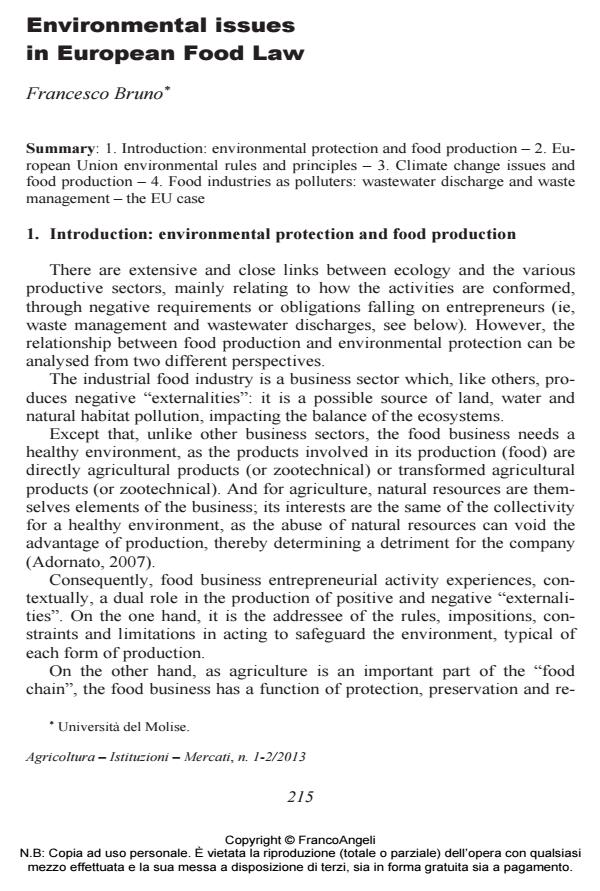Environmental issues in European Food Law
Titolo Rivista AGRICOLTURA ISTITUZIONI MERCATI
Autori/Curatori Francesco Bruno
Anno di pubblicazione 2015 Fascicolo 2013/1-2 Lingua Inglese
Numero pagine 9 P. 215-223 Dimensione file 38 KB
DOI 10.3280/AIM2013-001013
Il DOI è il codice a barre della proprietà intellettuale: per saperne di più
clicca qui
Qui sotto puoi vedere in anteprima la prima pagina di questo articolo.
Se questo articolo ti interessa, lo puoi acquistare (e scaricare in formato pdf) seguendo le facili indicazioni per acquistare il download credit. Acquista Download Credits per scaricare questo Articolo in formato PDF

FrancoAngeli è membro della Publishers International Linking Association, Inc (PILA)associazione indipendente e non profit per facilitare (attraverso i servizi tecnologici implementati da CrossRef.org) l’accesso degli studiosi ai contenuti digitali nelle pubblicazioni professionali e scientifiche
The work is focused on the relationship between food production and environmental protection, which can be analyzed from two different perspectives. Industrial food industry is a business sector which, like others, produces negative "externalities": it is a possible source of land, water and natural habitats pollution, impacting the balance of the ecosystems. Except that, unlike other sectors of business, the food business needs a healthy environment, as the products involved in its production (food) are directly agricultural products (or zoo-technical) or transformed agricultural products (or zoo-technical). And for agriculture, natural resources are themselves elements of the business, its interests are the same of the collectivity for a healthy environment, as the abuse of natural resources can void the advantage of production determining a detriment for the company. In this context, food business entrepreneurial activity experiences, contextually, a dual role in the production of positive and negative "externalities". On the one hand, it is the addressee of the rules, impositions, constraints and limitations in acting to safeguard the environment, typical of each form of production. On the other hand, being agriculture an important part of the "food chain", the food business has a function of protection, preservation and regeneration of the environment and biodiversity and is the recipient of specific rules. In this study is analyzing both the first regulations (in particular those for the protection of climate change) and the second (in particular those in defense of biodiversity), in a context of European law.
Keywords:Diritto alimentare, ambiente, cambiamenti climatici.
- Adornato F. (2007), «Food security and independent goverment bodies», in Adornato F., Logunov A.P. (eds.), Russia and Italy. The problems of food security, RSUH editor, Moscow.
- Albisinni F. (2012), «The Path of the European Food Law System», in Costato L., Albisinni F., European Food Law, Cedam, Padova.
- Carlson A. (2012), «Designing Effective Climate Policy: Cap-And-Trade and Complementary Policies», Harvard Journal on Legislation, 49. Germano’ A., Rook Basile E., Bruno F., Benozzo M. (2008), Commento al Codice dell’Ambiente, Giappichelli, Torino.
- Gerrard M., Kuh K. (eds.) (2012), The Law of Adaptation to Climate Change: United States and International Aspects, ABA, Chicago.
- Gerrard M., Foster S. (co-editors) (2008), The Law of Environmental Justice: Theories and Procedures to Address Disproportionate Risks, ABA, Chicago.
- Gerrard M. (ed.) (2014), Global Climate Change and US Law, ABA, Chicago.
- Roberts M., Alsbrook M. (2005), «United States Food Law Update», Journal’s Food Law and Policy, 187.
Francesco Bruno, Environmental issues in European Food Law in "AGRICOLTURA ISTITUZIONI MERCATI " 1-2/2013, pp 215-223, DOI: 10.3280/AIM2013-001013